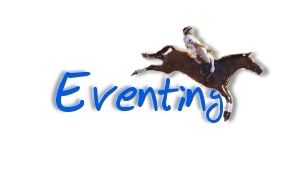
And from these origins we have the modern "eventing" (also known as "combined training) Like 'military' eventing tests the horse's suppleness and maneuverability, stamina and endurance and finally the horse's fitness and strength. These factors are tested through the 3 phases of an event; Dressage, Cross Country, Show Jumping (Stadium Jumping). For sure, eventing is probably one of the most 'specator appealing' equestrian sports.
There are 2 types of events that one can compete in...
The One Day Event: (ODE)
As explained by its name,
the One Day Event occurs over one day. Usually this type of event is the
more informal introduction to 3DEs (explained later) These are held mostly
by pony clubs, or riding clubs of sorts. Anyhow, the ODE is comprised of
the 3 phases: Dressage, Cross Country, and Show jumping.
The 3-Day Event: (3DE)
Like the ODE, the 3DE is
comprised of the 3 phases: Dressage, Cross Country, and Show jumping. BUT,
the 3DE (like explained by its name) occurs of 3 days. Dressage is on the
first day, followed by cross country on the second and show jumping on
the third. 3DEs are most common in state/provincial or national/international
level eventing competitions.
Phases of the ODE/3DE...
Dressage is always held first (at the start of the day). The dressage phase consists of a ridden flatwork 'test' for horse and rider. Your aim is to get as high a percentage/score as possible; ride a precise/correct course . You will receive the test prior to the day of the event (the difficulty of the test will be allocated according to the level you wish to compete) You are expected to memorise the set of figures and movements in order. Each figure/movement will be marked out of 10, based on correctness, suppleness, position, obedience etc. The marks out of 10 will then be added up and given as your final score (or converted into a percentage). eg. If there are 10 sets of movements, it means that the perfect score will be 100. If you score 6 on each movement (it is highly unlikely you will score the same mark on each movement) that means you have achieved 60/100 or 60%. You will get penalties for errors of course or test.
Cross Country is the next phase. This consists of a course over different terrain with built/solid jumps (or naturally fallen logs etc.). You will receive a map of the course and will be able to walk the course either the day before the event or in the morning before the first horse has begun the phase. Your aim is to ride the course without gaining any penalties or time faults ie.as quickly and correctly as possible.
| Faults at Obstables... | Penalties |
| First refusal, run-out or
circle
Second refusal, run-out or circle Third refusal, run-out or circle |
20
40 elimination |
| Falls... | |
| Fall of horse and/or rider
Second fall of horse and/or rider |
60
elimination |
| Penalty Zone... | |
| Leaving and re-entering the Penalty Zone (if used) | 10 |
| Time Faults... | |
| Exceeding the optimum time
for the course
Exceeding the time limit (twice the optimum time) |
0.4 penalty points/sec
elimination |
Show Jumping is the last phase of the event. It tests the horse's and rider's ability to still 'function' after the strain of the last 2 phases. This held in an 'enclosed' area or arena where jumps are set up (the height according to the level in which you are competing) in a particular course; the jumps being composed of poles and wings. Your first aim is to complete the course without getting any faults. If there are a few competitors that have achieved clear rounds (ie. no faults) then there will be a jump-off in which there will be a tough course made and your aim then is to jump clear and quick. The person with the least faults and quickest time will then be in the lead for the showjumping phase.
Below is a table of possible penalties...
| Jumping faults... | Penalties |
| Knocking down an obstacle, touching the coundary mark of a water jump or foot in water | 5 |
| First disobedience on course | 10 |
| Second disobedience on course | 20 |
| Third disobedience on course | elimination |
| First fall of horse and/or rider | 30 |
| Second fall of horse and/or rider | elimination |
The horse you ride is only capable of doing what you are capable of. Don't try and attempt anything that you feel you or the horse is not ready for. Any equestrian discipline (but esp. jumping) can prove challenging and in the case of an accident can prove extremely confidence shattering or even fatal. Only do what you are confident with! So take care out on the course and remember that 3-letter word...have FUN!
© 2000 - Carolyn's Horsey Homepage
Content and/or images must not be taken without permission from the webmaster